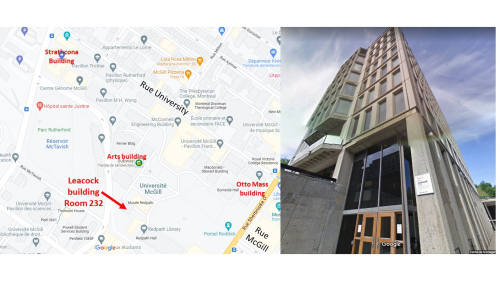FEMR Materials Day 2022
Thursday, November 3, 2022
1:00-5:00 pm
McGill University
Room 232, Leacock Building
855 Sherbrooke Street West, Montreal, QC H3A 2T7
Join us for talks on the application of electron microscopy in materials science at the Facility for Electron Microscopy Research.
Electron microscopy is one of the preeminent characterization tools for materials science. Join us for talks and participate in discussions on recent techniques in electron microscopy.
Plenary Speaker: Emilie Ringe, Ph.D., Department of Materials Science & Metallurgy/Department of Earth Sciences, University of Cambridge - Revealing the shape, composition and plasmon modes of magnesium nanoparticles with electron microscopy and spectroscopy.
Abstract:
Localized surface plasmon resonances (LSPRs) are coherent oscillations of conduction electrons that turn a metallic nanoparticle into an antenna for light, enabling for instance photocatalysis and photothermal cancer therapy. Magnesium is an up-and-coming, cheap and biocompatible plasmonic material, with multiple studies reporting fabricated structures in the past decade. My group in Cambridge focuses on the understanding and exploitation of colloidally synthesized magnesium nanoparticles. These syntheses produce metallic magnesium nanoparticles coated with a thin protective oxide layer; they adopt unusual particle shapes owing to magnesium’s hexagonal close-packed lattice. This talk will discuss how we used electron microscopy to reveal shape (crystallography and tomography), composition and oxide formation (EDS, EELS, HRSTEM), as well as the local distribution of optical losses due to plasmon resonances (EELS).
Bio:
Emilie Ringe started her undergraduate studies at McGill in chemistry, and finished her degree summa cum laude, in chemistry, at Northwestern University. She then obtained her Ph.D. at Northwestern (2012) and then was a postdoctoral fellow in Materials Science at the University of Cambridge, UK. In 2014, she was hired as an assistant professor at Rice University, where she established the Electron Microscopy Center. In 2018, she moved back to the University of Cambridge, joint between the Department of Materials Science and Metallurgy and the Department of Earth Sciences; she was promoted to full professor in 2022. She received an ERC Starting grant and a EPSRC grant to pursue her studies of Earth-abundant plasmonics, for which she has been named one of the 2021 C&EN’s “Talented 12” and recipient of the 2021 The Journal of Physical Chemistry C and ACS PHYS lectureship
Keynote Speaker: Kenneth Beyerlein, Ph.D., Centre Énergie Matériaux Télécommunications, Institut national de la recherche scientifique - Watching phase transformations with a dynamic transmission electron microscope.
Abstract:
Computational initiatives like the Materials Project have amassed structure and energetic information on nearly 150,000 materials with the goal of accelerating the discovery of materials with enhanced properties. However, it remains a challenge to synthesize many of the predicted phases, largely due our inability to control the phase transformation process. Better understanding of the energy transfer mechanisms and kinetic pathways involved is critical for accurate prediction of the product phase and microstructure. This insight requires studying the local changes happening on the atomic and nanometer scale during this process. However, measurements of this kind are limited due to the extreme temporal and spatial resolution required. The Dynamic Transmission Electron Microscope (DTEM) has been recently developed to address this challenge, and is capable of imaging irreversible transformations in materials with nanosecond and nanometer resolution. In this talk, an introduction to the operating principle of this microscope and the challenges of snapshot imaging with electrons will be given. A current benchmark of the capabilities of the DTEM at INRS will be presented, along with planned future developments.
Bio:
Dr. Kenneth Beyerlein is an Assistant Professor at INRS-EMT, where he is responsible for the Dynamic Transmission Electron Microscope laboratory. His research uses novel time-resolved microscopy techniques to investigate the structure and dynamics of functional materials for energy applications. More specifically, his group is interested in uncovering new metastable phases of matter created by light excitation. He published extensively on this topic, including a sole author PNAS article, during his time as a post-doc at the Max Planck Institute for the Structure and Dynamics of Matter and Center for Free-electron Laser Science in Germany. He holds a dual-PhD in Materials Science and Engineering from the Georgia Institute of Technology (USA) and the University of Trento (Italy), which was recognized with the Young Scientist Award from the European Powder Diffraction Conference.
Technical Speakers: Stéphanie Bessette, Weawkamol Leelapornpisit, and Jesus Angel Valdez Aguilar.
Flash talks: Post-doctoral Fellows and Graduate Students.
